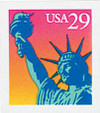
# 2599 - 1994 29c Statue of Liberty, self-adhesive
US #2599
1994 Statue of Liberty
- Second self-adhesive stamp issued in 1994
- Pictures a famous American landmark
Category of Stamp: Definitive
Value: 29¢, First-Class mail rate
First Day of Issue: June 24, 1994
First Day City: Haines City, Florida
Quantity Issued: 539,930,000
Printed by: Avery Dennison Security Printing Division for Dittler Brothers
Printing Method/Format: Photogravure. Panes of 18, from printing cylinders of 540 (30 booklets, 5 across, 6 around)
Perforations: Die cut
Reason the stamp was issued: This self-adhesive stamp was issued for use on First Class mail.
About the stamp design: The image of the easily recognized Statue of Liberty. IT has been the subject of more than 25 US stamps, envelopes, and postal cards. Tom Engeman was the artist behind this stamp. It shows the statue’s head and arm with a sunset in the background. Engeman photographed a miniature replica of the statue from different angles before deciding on the view he wanted to portray on the stamp. He then painted the design in acrylic.
First Day City: The Statue of Liberty stamp was dedicated during the Americover 94 exhibition, held at the annual meeting of the American First Day Cover Society. The exhibition took place in Haines City, Florida.
History the stamp represents: The Statue of Liberty is a magnificent copper sculpture given to the United States by France in 1884. On October 28, 1886, the statue was dedicated. Its complete name is Liberty Enlightening the World. This majestic symbol of the United States, representing freedom for immigrants coming to America as well as the bond of freedom shared between the United States and France, stands above Liberty Island at the entrance to New York Harbor in Upper New York Bay.
The people of France donated the money to build the statue, and the people of America raised the funds to build its base. The French sculptor Frédéric Auguste Bartholdi designed the statue and chose its location. Alexandre Gustave Eiffel, the French engineer who later built the Eiffel Tower in Paris, designed the statue’s framework. The statue stands 301 feet and 1 inch high from foundation to torch.
In the early 1980s, a program was started to make major repairs and improvements to the statue. This effort concluded in 1986 – the 100th anniversary of the Statue of Liberty’s dedication in the US. A popular tourist attraction, the statue attracts about 2 million visitors each year.
US #2599
1994 Statue of Liberty
- Second self-adhesive stamp issued in 1994
- Pictures a famous American landmark
Category of Stamp: Definitive
Value: 29¢, First-Class mail rate
First Day of Issue: June 24, 1994
First Day City: Haines City, Florida
Quantity Issued: 539,930,000
Printed by: Avery Dennison Security Printing Division for Dittler Brothers
Printing Method/Format: Photogravure. Panes of 18, from printing cylinders of 540 (30 booklets, 5 across, 6 around)
Perforations: Die cut
Reason the stamp was issued: This self-adhesive stamp was issued for use on First Class mail.
About the stamp design: The image of the easily recognized Statue of Liberty. IT has been the subject of more than 25 US stamps, envelopes, and postal cards. Tom Engeman was the artist behind this stamp. It shows the statue’s head and arm with a sunset in the background. Engeman photographed a miniature replica of the statue from different angles before deciding on the view he wanted to portray on the stamp. He then painted the design in acrylic.
First Day City: The Statue of Liberty stamp was dedicated during the Americover 94 exhibition, held at the annual meeting of the American First Day Cover Society. The exhibition took place in Haines City, Florida.
History the stamp represents: The Statue of Liberty is a magnificent copper sculpture given to the United States by France in 1884. On October 28, 1886, the statue was dedicated. Its complete name is Liberty Enlightening the World. This majestic symbol of the United States, representing freedom for immigrants coming to America as well as the bond of freedom shared between the United States and France, stands above Liberty Island at the entrance to New York Harbor in Upper New York Bay.
The people of France donated the money to build the statue, and the people of America raised the funds to build its base. The French sculptor Frédéric Auguste Bartholdi designed the statue and chose its location. Alexandre Gustave Eiffel, the French engineer who later built the Eiffel Tower in Paris, designed the statue’s framework. The statue stands 301 feet and 1 inch high from foundation to torch.
In the early 1980s, a program was started to make major repairs and improvements to the statue. This effort concluded in 1986 – the 100th anniversary of the Statue of Liberty’s dedication in the US. A popular tourist attraction, the statue attracts about 2 million visitors each year.








